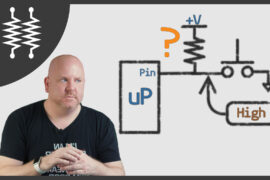The two most popular kinds of transistors you might use for a project are either BJTs or MOSFETs. With so many options, it was tough to pick just a few.
We covered the 2n3904 in this video. What BJTs are your favorites and why? Leave a comment below.
Transistors are electronic switches that are used to control things that would kill an Arduino, Raspberry Pi, or Beaglebone. There are two major types known as a BJT and MOSFET. This is part 1 of a two part series, which looks at BJTs first.
Learn what they are and how to use them.
Don’t forget to subscribe to the AddOhms YouTube channel to know when Part 2 on MOSFETs is released!
Episode Notes
Suggested links for Ep10:
-
The best four transistors to keep in your toolbox [baldengineer.com]
-
Fairchild 2n3904 Datasheet (BJT NPN Transistor) [fairchild.com]
Inside a NPN BJT

Zeptobars.com has an awesome picture of the die inside of a Fairchild S9014 BJT NPN. Zeptobars.com has a ton of other great images, check out their bare die pictures.
Support AddOhms
Support AddOhms
Support AddOhms by joining the Bald Engineer’s Patreon.


